How to Make Money on Fiverr: The Exact Steps I Took to Make $2-3k Every Month
“How do you find success on Fiverr? How to make money on Fiverr?”
I get these questions several times a week, from fellow Fiverr sellers who are just getting started on the platform. Of course, the answer is too complicated to distill into a quick response, hastily sent off.
Luckily for the next person who asks, I can send a link to this guide: a comprehensive look at my best tips for how to make money on Fiverr.
But why are people asking me for advice?
🥜 BONUS: How to make money on Fiverr in a nutshell
- Sign up as a Fiverr Seller.
- Brainstorm the Gigs you want to set up.
- Create a compelling Fiverr profile.
- Research how the competition is setting up their Gigs.
- Take a first attempt at setting up a Gig, then ask someone in your industry to review it and point out anything that isn’t clear or compelling.
- Refine your initial attempt at setting up a Gig with representative imagery, a clear title, a keyword-rich description, relevant search tags, and a helpful FAQ.
- Set Gig requirements that aim to get all relevant information from the buyer to limit the need for revisions.
- Acknowledge every incoming order, if only to keep your metrics high.
- Set aside a specific time each day to address client communications and to work on Fiverr orders.
- Use client feedback to refine Gig messaging (including FAQs), Gig extras, and to launch new Gigs.
- Underpromise and overdeliver whenever possible.
How to make money on Fiverr – how I make $2,000-$3,000 each month
I’ve been on Fiverr since June 2015.
I honestly wouldn’t have even considered it if not for the guidance of my mentor and first big client when I started freelancing full-time. He’d been using it to sell social media management packages that he eventually converted to long-term client relationships.
With 4.5 years on the platform, I’ve seen Fiverr grow from having a bad reputation that stemmed from making every order start at $5, to a diverse marketplace of talented individuals who have learned how to make money on Fiverr by charging according to their skills and experience.
Between June 2015 and the date of this article’s publication, there’s been some variance in terms of how much work I’ve actually done through the platform. But I never left completely or went on an extended break, always maintaining a consistent presence.
It’s this consistency that’s helped me move up from one seller level to another.
I’m both a “Top Rated Seller” and a member of the Pro marketplace, which effectively puts me on the top of the totem pole for getting my Gigs surfaced in relevant searches on Fiverr — while also providing justification for my pricing.
It’s worth noting that you don’t become a Top Rated Seller or a member of the Pro marketplace without first being vetted by the Fiverr team. Unlike other Fiverr seller levels, neither happens automatically by achieving certain milestones.
It wasn’t until 2019 that I became a Top Rated Seller. Now more than ever, I get a consistently high quantity of new orders across all of my Gigs with minimal effort.
Perhaps because of how long I’ve been on the platform, and the nature of what I do (primarily content writing), Fiverr staff regularly reaches out to buy my Gigs.
I’ve written for And.co, Veed.me, some ghostwriting for Fiverr’s website, and have also been featured on Fiverr’s blog when I became a Pro seller.
Along with the launch of the Pro marketplace, I was featured in advertisements alongside the likes of Jerry Media (of @f***jerry Instagram fame):

All of this is to say that I’ve definitely caught some lucky breaks on the platform but that I probably wouldn’t have been approached for them without having good consistency and tenure as a Fiverr seller.
Starting in 2019, I’ve made $2,000-$3,000 a month on Fiverr alone (which doesn’t represent the majority of my freelance income) — and I’m going to walk you through everything you need to do to learn how to make money on Fiverr.
How Fiverr works for freelancers
The major difference between popular freelance marketplaces like Upwork and Fiverr is the process of working with clients.
Working with clients on Upwork means constantly pitching for new jobs. So new work doesn’t happen in the background without your input — you have to be proactively on the hunt for new work when you want it.
Fiverr is a completely different story.
With Fiverr, you essentially productize your service via Gigs.
Each Gig describes a specific deliverable you will provide in exchange for a set price, starting with the words, “I will…”
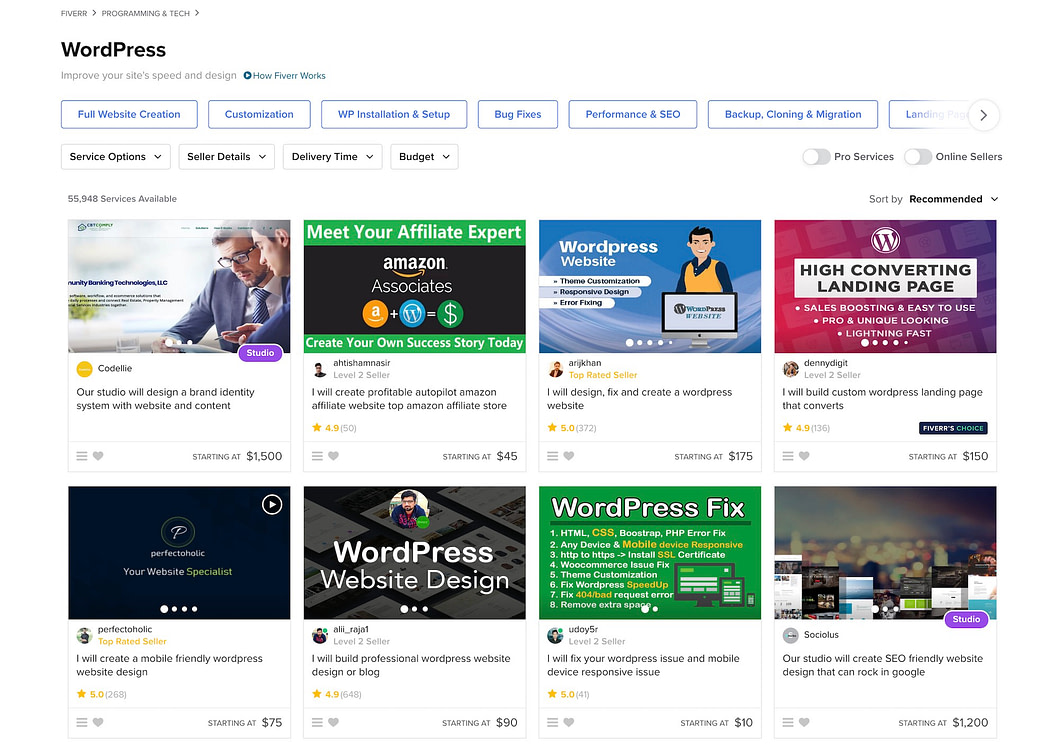
You can offer different packages that involve bare-bones offerings, up to “the works”. You can also offer Gig extras that allow people to customize your offering with related services they’ll benefit from.
But the best part about Fiverr is that because of the way Gigs are set up, clients are empowered to make purchases without even talking to you.
This means that if your Gig is the right fit for their needs, at the right time, you can be making sales while you sleep.
Undoubtedly, from time to time, people will still get in touch with questions or to ask for custom deliverables. Using Fiverr doesn’t mean that you can do away with business development completely, though it will certainly help you streamline the process.
At the end of the day, if you want to make more money as a freelancer, reducing the time you spend actively pitching for jobs means that you have more time available to do the work.
With that said, let’s now answer the first question people have when starting their careers on Fiverr:
What to sell on Fiverr
I’ve previously written on how to grow your business with Fiverr for WPMU DEV, including several ideas for what Gigs to set up.
Personally, I have Gigs to help people with user testing, SEO audits, and creating blog content. But that’s just me, and most readers will probably want to explore other options.
When deciding what to sell on Fiverr, the best place to get inspiration from are Fiverr’s own category pages. You’ll find tens of different categories and subcategories there, and all of them feature multiple Gigs.
Browse through those categories and visit the ones that play to your strengths. Then browse through the individual Gigs and take note of everything that looks like something that you could offer as well.
Note down what you like about each existing Gig and its description, what you don’t like, and what you would do to make your offer stand out. Mimicking your competition at least to an extent is the easiest way to get started and find the exact types of Gigs that people actually want to buy.
“What if I want to offer something that’s not on the platform yet?” Well, at first, offering a completely original Gig may seem like tapping into a hidden niche, but it’s usually not like that at all. If you can’t find your Gig on the platform then it probably means that customers are not really that interested in it.
In business – and even in web design business – competition is good. The sole presence of competition validates the market. No competition, no market.
For example, the Programming & Tech category covers a wide range of deliverables that may speak to your skills. For a web developer, Fiverr Gig offerings might include setting up a basic website, offering WordPress maintenance services, fixing bugs, implementing security tools, customizing plugins, or building landing pages. If you want to join the platform as a new developer, doing something from this range is likely your best bet.
Only later on you can experiment with other Gigs or more tailor-made offers. For example, something I started doing recently is connect the dots between my UX and SEO audit Gigs for buyers.
People may not realize that I can offer both services when initially coming across one Gig or the other. I now offer the ability for someone to buy the other Gig (the basic package) on the one they’re currently looking at. I’ve been pleasantly surprised by how well these upsells are performing — I hope this same strategy can help you!
On a related note, for complementary services that customers request but you either can’t or don’t want to do, consider setting up a Fiverr Studios Gig where you can work with another seller and both share in the profits.
Something like this would be a great fit for my SEO or UX audit Gig, which both involve diagnosing website issues, then partnering with another seller to make website edits that will help buyers pass a future audit.
Now that you’ve had a chance to see what’s possible with Fiverr, let’s dig into the single most important facet of finding success — how to set up a stellar Fiverr Gig.
How to set up a successful Fiverr Gig
One of the most important things you can do when learning how to make money on Fiverr is to be very purposeful in constructing your Gigs.
Here are the Gigs I’m currently offering and some associated statistics regarding performance in search and conversions over the last six months:
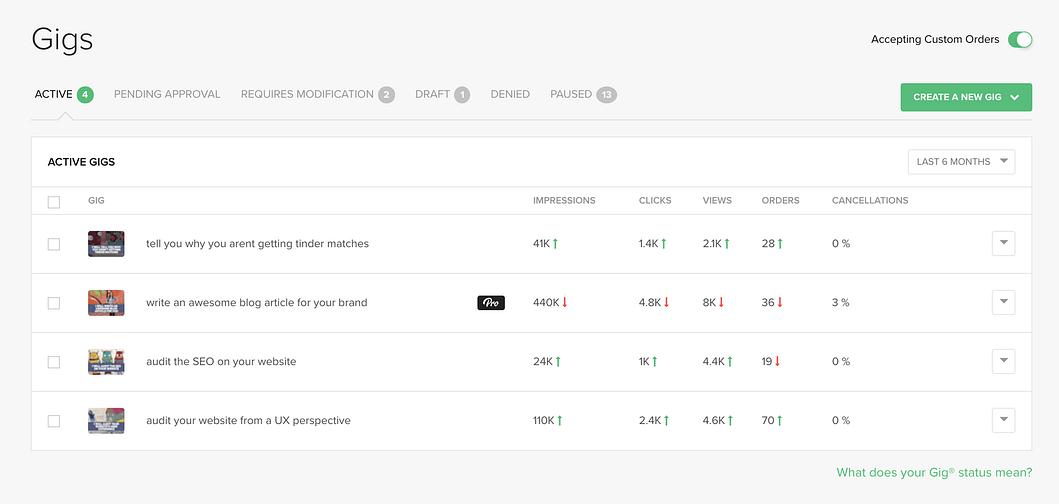
Initially, you’ll be limited by how many Gigs you can set up, as well as how many Gig extras (upsells), and Gig multiples (multiple quantities of your Gig’s deliverables) you can offer. As you move up each seller level, you’ll have increasingly fewer restrictions in each of these areas.
These initial limitations might be frustrating if you have a lot of ideas for what to sell on the platform — but try to think of them as a good thing when you’re just starting out. The fewer services you sell, the easier it will be to create a great process around producing deliverables and providing a great buyer experience.
Here’s what I love most about Fiverr:
Setting up a Fiverr Gig will force you to “productize” your services.
Specifically, this means clearly outlining the deliverable that a buyer will receive for a certain price. These deliverables can be further personalized to the buyer’s needs in terms of various packages, Gig extra upsells, and Gig multiples.
The beauty of productizing your services for Fiverr is that they will be easier to quote on the fly, like when a client gets in touch for a custom order. By having some standardization around your offerings, it will also be easier to create processes around executing similar orders — saving you time and increasing your potential outputs.
By having forced limitations at the beginning of your time on Fiverr, you’ll be forced to focus on productizing the services you’re most confident about. With this narrow focus, you’ll figure out how to create efficiencies.
Fellow $2000+/month Fiverr Seller, Shahzad Saaed, talks about a landing page design Gig that he scaled nicely by repurposing templates so that the deliverable was a no-brainer.
I feel a similar way about my UX audit Gig. They’re quick for me to do and I can knock out a bunch of orders in no time.
So what could you offer?
Stew on that for a bit while we go through some important considerations related to setting up your Gigs:
Fiverr Gig visuals: images and video
“Don’t judge a book by its cover” shouldn’t be your guiding mantra while setting up a Fiverr Gig.
In truth, the way you merchandise your Fiverr Gigs will have a big impact on whether people ever actually click through from a related search and make a purchase.
Fiverr PR Manager Holly Steffy shares these best practices:
- We recommend including an eye-catching main Gig image (608 x 410px or higher and similar size ratio). The main image should reinforce the service and be professional and premium looking. It should look professional regardless of the category, and the images should be copyright-free.
- We also recommend having minimal text within the image (20% or less of the image).
- For visual categories, the best practice is to show a single work sample per image.
- For non-visual categories, the image should represent the service being delivered and should instill confidence that the seller is professional and capable of delivering a high-quality experience. However, every Gig image for visual and non-visual categories should have its own unique image.
I’m not sure that my images follow all these guidelines perfectly but they haven’t gotten in the way of me learning how to make money on Fiverr.
I’ve redesigned my Fiverr Gig images recently to reflect my own branding aesthetics:
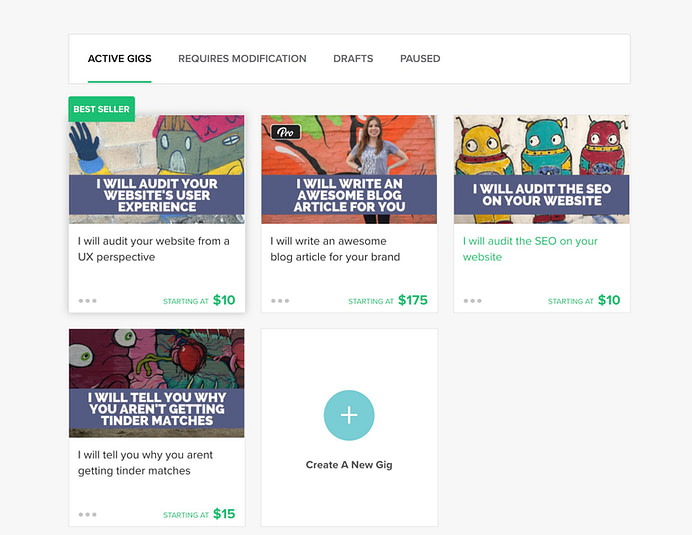
It’s worth noting that if you’re on the Pro marketplace, it may be useful to include a picture of yourself in your main Gig image — especially if you’re well known in your field.
Besides the main visuals you use to help distinguish your Gigs, you should also consider adding videos to introduce yourself (and your expertise) while also explaining what people get when they make an order, as well as Gig extras they can purchase and why they’re worth the extra cost.
Gig videos don’t have to be a high-production ordeal — just film yourself on a non-busy background, dressed professionally, and clearly articulating the value of working with you specifically.
The Gig description: sell your offer with great copy
Like a sales page elsewhere online, the Gig description is likely what will make the difference between someone buying your Gig — or another seller’s.
So make sure to flesh out the details of the deliverables offered at each level (and Gig extras) to the best of your ability, to set expectations. Doing this also increases your efficiency with producing the deliverable — reducing the chance that someone will want modifications because they didn’t really understand what they were buying.
Try searching for the type of service you plan to offer on the Fiverr marketplace to see how other people are talking about it, including what specific words they use to describe it.
Please note: The section “How does the Fiverr search algorithm work?” offers more details for Fiverr SEO and incorporating relevant keywords on your Gigs. 👈
When writing your Gig description, anticipate questions that people will have. Convince buyers that you’re the best person for the job by also making sure to detail your relevant experience.
If you offer other related Gigs, mention them in the description with a call to action for the buyer to check them out.
Don’t forget to format your copy for easy readability so that important things stand out.
Here are some quick tips for great copy formatting:
- Use text decorations (bold, italic, underline) to add emphasis
- Use bullet points to make lists easy to read
- Keep sentences and paragraphs short so prospects aren’t overwhelmed with a wall of text
With all of these considerations in mind, here’s the Gig description for my UX audit Gig:
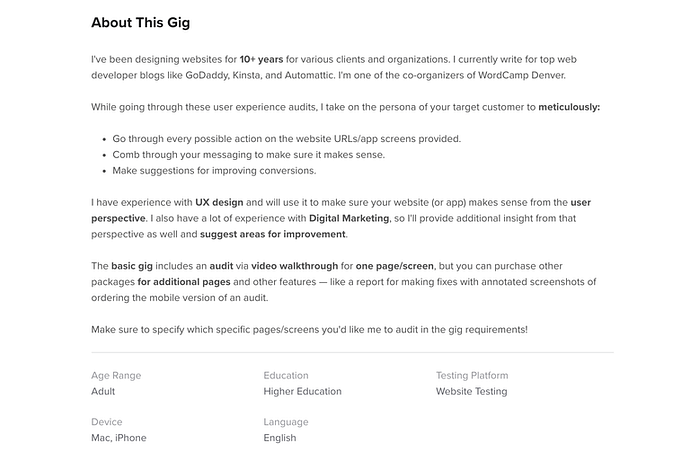
Upsell with packages and Gig extras
In thinking about how to sell your services on Fiverr, you’ll want to think in terms of basic, standard, and premium packages.
In other words:
- What’s the most bare-bones version of your service?
- What can you do to provide more value in a standard package compared to your basic offering?
- What deliverables would be associated with a package that includes all the bells and whistles?
Here’s how I set up my Gig packages for my UX audit gig:
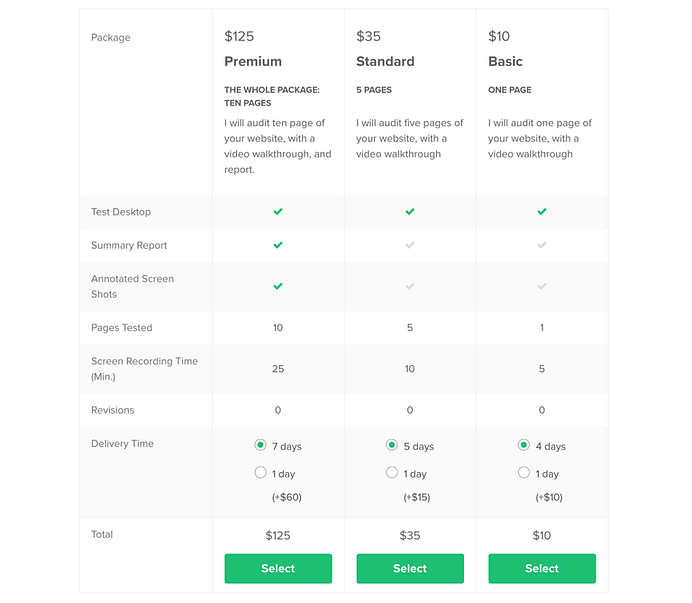
There are buyers that represent diverse budgets on Fiverr, so you might as well offer options to appeal to them all, by creating packages that make sense for different use cases.
Besides packages, you’ll want to create upsell opportunities by setting up some Gig extras.
Gig extras provide buyers with the opportunity to order more of the same deliverable (like more pages audited on my UX audit Gig), get your order delivered quicker (like a fee for one day turnaround), or complementary services (I sell a gig extra for a UX audit on my SEO audit Gig and vice-versa).
I highly recommend offering options for one day turnaround if you can stay on top of these orders — this is an easy moneymaker.
Just make sure to be realistic with delivery dates in general.
Give yourself enough time to fit in a surprise one day turnaround order on top of your regular workload. Or forecast your likely Fiverr workload and set aside time for it on your calendar.
To give you an idea about how this works in reality, here are the Gig extras on my UX audit Gig:
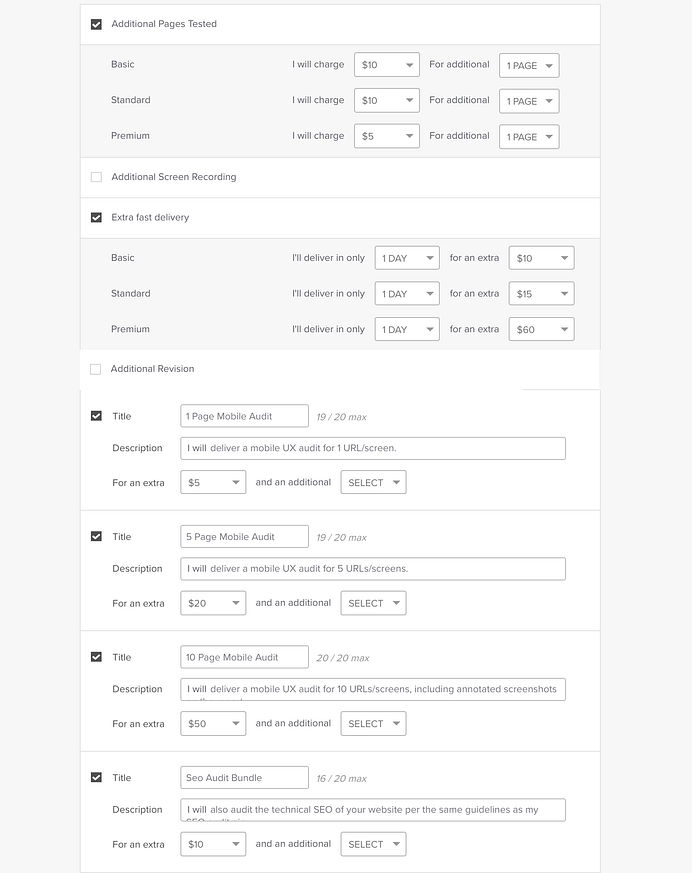
You’ll notice that some options are pre-populated suggestions based on the Gig category, like testing additional pages or offering additional screen recording minutes. Additionally, some of the Gig extras options I’ve added in are based on what customers have asked for in the past.
Using Fiverr means standardizing your offerings for each Gig. But by employing the strategic use of Gig packages and Gig extras, you’ll make people feel like you’re trying to cater to them specifically — and they’ll appreciate that.
Set expectations with Gig requirements and the FAQ section
The best part of using Fiverr is that it facilitates sales without you needing to do any business development work personally.
You can further cut down your work on back and forth communication with a thorough FAQ section and Gig requirements questions.
It’s important to put forth the effort necessary to properly set up these sections, because to me, the whole point of using Fiverr is to help cut down on time spent on business development — allowing more time to focus on the work, itself.
Use the FAQ section to proactively answer people’s questions. Specifically, the FAQ should anticipate common questions about your process and deliverables.
Here’s the FAQ for my UX audit Gig:
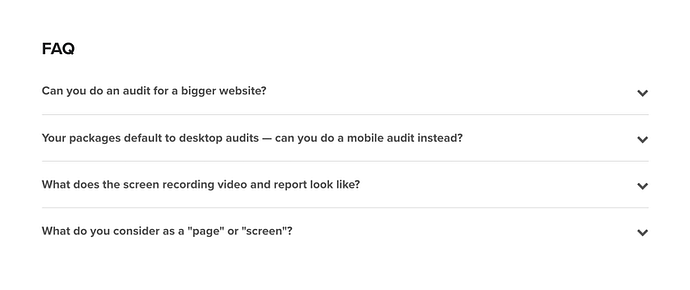
If you’re stumped right now, you’ll find that your Fiverr inbox will offer plenty of ideas for FAQs after you launch a new Gig.
Once you get the same sort of question more than once, that’s a good sign that you’re not sharing everything people really need to know before buying your Gig. You won’t realize how annoying it can be to answer these messages over and over again until they become a frequent daily occurrence.
That said, some buyers won’t take the time to read through your Gig description (and supportive details) before getting in touch with their questions. Try not to be annoyed — we are all guilty of skipping ahead to get in touch with customer support directly over trying to browse FAQs.
Another best practice for your FAQ: share the specific questions that you ask on your Gig requirements after a person places an order. This will help buyers visualize working with you.
One major limitation in terms of what you can share in your FAQ (or elsewhere, publically on Fiverr) is clickable links, like those that would lead to similar projects shared on your portfolio.
That said, you can upload examples of your work directly to Fiverr to serve as your portfolio.
Gig requirements for programming and tech Fiverr Gigs
Setting up Gig requirements is useful in terms of minimizing back and forth with a project while ensuring that you’re creating a final product that your buyer will be happy with.
Wondering what to ask your customers in the Gig requirements section?
Fiverr PR Manager Holly Steffy shares that common basic requirements in the Programming and Tech category include:
- Website URL and log-ins
- Hosting log-ins
- Photo or text that should be included
- Examples of inspiration from other websites (if the seller is creating a new website for the buyer)
- Ask the buyer about their business and their goals for the website
Here’s another perspective — what I ask buyers on my UX audit Gig:
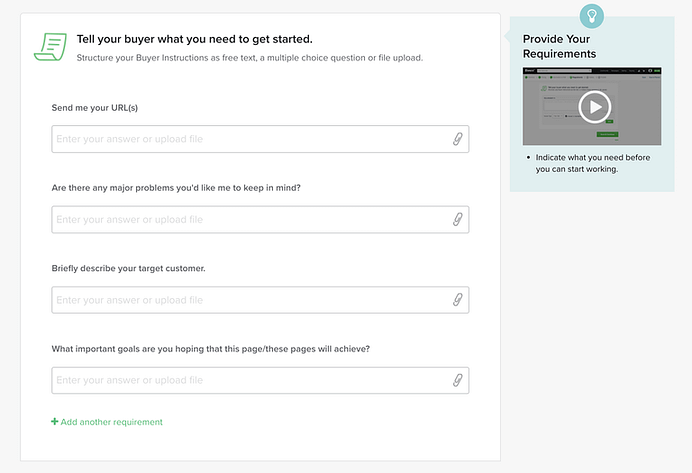
How to price your Fiverr Gigs
According to Holly Steffy, PR Manager for Fiverr, when sellers are considering how they should price their Gig, they are asked to consider the following:
- If they work offline, how much do they charge offline?
- How much do they want to make per hour (and how many hours would this job take)?
- How much does their competition charge on Fiverr, especially those who are at the same level and with the same amount of experience and skills?
- How much does their competition offline charge for this service?
If you want to learn how to make money on Fiverr, you’ll have to be competitive with similar Gigs in your category — at least to an extent. Being on the Pro marketplace changes the rules to allow for more variations in pricing while still delivering on quality.
Hee’s the most important question you’ll probably want to answer before getting started on Fiverr:
“Do I really have to start by pricing my Gigs at $5?”
Here’s what I’ve found to be true:
If you’re starting off by jumping straight into the Pro marketplace, the answer is: definitely not. In fact, pricing your Gigs too low on Fiverr Pro may signal that you’re out of your league compared to other sellers at this level.
On the other hand, if you have no tenure on the platform and are starting completely fresh, having at least one low priced Gig can work in your favor in terms of building up your metrics, orders, and ratings — all necessary for levelling up.
The key to delivering quality without burning out lies in offering a service that you can complete quickly.
For me in the past — before levelling up — these have included five-minute screen recordings for my UX audit Gig and SEO audit reports that are generated automatically by one of my favorite SEO tools, with some commentary about what issues to fix immediately and why.
All that said, once you’ve acquired some social proof from being a reputable seller (higher levels and/or great reviews), there’s absolutely no reason to offer any Gig starting at $5.
How does the Fiverr search algorithm work?
There are many factors that determine how a Gig ranks in relevant search.
Like Google, the specific details regarding Fiverr’s search algorithm are a trade secret. But it seems fair to assume that components might include:
- How many five star reviews you have total and your average star rating
- Total orders completed
- Seller level
- A weighted average of your metrics, judged on a scale from “good” to “bad” (anything under 90% seems to fall in the realm of “bad”, at least according to the requirements for maintaining Seller levels)
- Strategic use of keywords in your Gig title, description, and uploaded image/video file names
Though dated, a 2015 Inet Solutions article suggests Gig views and orders in queue as additional potential ranking factors, which makes a lot of sense to me. Just Entrepreneurship shares some additional thoughts on ranking signals and relevant tips to adjust your gigs.
If you know the basics of on page SEO in general, you’ll be well prepared for setting up a Gig optimized for Fiverr search.
The main difference between these two types of search?
On Fiverr, your interactions with customers are going to have just as much of an impact on your placement in relevant search as the way you optimize various settings on a Gig.
Here’s another possible Fiverr search ranking factor:
If you’re late to deliver a Gig, Fiverr deploys a banner that chastises you for being late, with a notice that doing so can reduce orders by 10%.
It’s unclear whether this is because of a search algorithm factor or because of buyers’ reactions to your average delivery time metric on the Gig page (or both).
Fiverrcast Episode 13 shares some additional tips for Fiverr SEO, endorsed by Fiverr by nature of being published on their blog:
- Create a Gig for each specific service so that you’re not underoptimizing for related keywords.
- Make sure you’re categorizing Gigs correctly.
- Don’t stuff keywords (overusing them to the point of coming across unnaturally).
- Flesh out your Gig description with copy that uses relevant keywords.
- Understand that image file names affect Google indexation. Fiverr’s First Ever Super Seller and Official Ambassador, twistedweb123 (Adam) mentions that it’s important to name your Gig’s image files according to what you’re delivering.
During this Fiverrcast podcast episode, Adam also says: “Fiverr tells [Google] to try and use the first kind of sentence or two of your description to show in the search engine results”.
A Google search for my username and the word “Fiverr” returned templated responses that didn’t pull directly from my Gig descriptions:
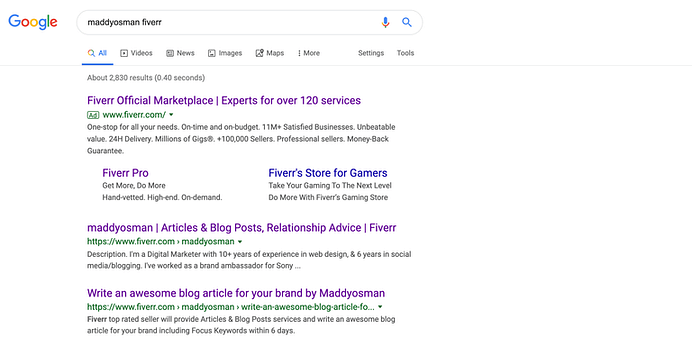
So with that said, I didn’t agree with every characterization of SEO they generalized about on the aforementioned Fiverrcast episode about Fiverr SEO, but there were good tips shared all the same.
Furthermore, this podcast episode shares tips that help with a mix of internal search and indexation on Google — but not either topic independent of the other.
But here’s something that we can say definitively:
According to Holly Steffy, PR Manager at Fiverr, the top searches in the Programming & Tech category include the terms: WordPress, E-Commerce, Website development, Shopify, and Website Design.
Here’s one last thing we have some Fiverr guidance for regarding how search works: how to use search tags to get more impressions on Gigs.
Some Fiverr search tag best practices include:
- Using tags to describe the specific services and industries you serve.
- Max out your ability to add five relevant tags.
- Don’t try to use special characters and duplicated terms — they will be ignored.
Fiverr vs other popular freelance marketplaces
CodeinWP shares a list of seven popular WordPress freelance marketplaces and job boards but that number is really just the tip of the iceberg. For every specialized niche, there’s a marketplace where you can find people to help with related tasks.
When it comes to freelancing, two big names tend to dominate the conversation in terms of where to maintain an active presence: Upwork and Fiverr.
Upwork and Fiverr: mergers, acquisitions, and IPOs
Both Upwork and Fiverr have been making bold moves to grow their spheres of influence.
Specifically, Upwork merged with two companies of a similar nature: oDesk and Elance.
Fiverr has also made moves to merge with similar freelance marketplaces, such as Veed.me (video production marketplace) and ClearVoice (content writing platform). What’s even more interesting is Fiverr’s interest in acquiring tools that help freelancers manage their business, like And.co.
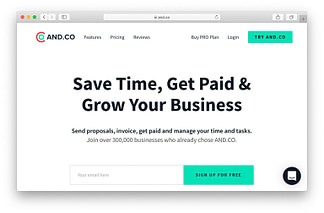
👉 Read also: time management for freelancers with no time
There’s a notable difference in the size of each company at publication, though I’m not sure how much it matters to sellers:
Fiver is closing in on a million sellers on their marketplace — 830,000+ at publication. Although Fiverr doesn’t break the number down by verticals, there are thousands of sellers represented in web design and development categories.
So how does this compare to Upwork?
A 2018 Inc article quoted a May 30 speech by Mary Meeker. According to Meeker, Upwork had 16 million freelancers on its platform, which represented a 23% increase between 2017 and 2018. This was the most specific and up-to-date data I could find regarding the number of Upwork’s freelancers.
Interestingly, the gap between the number of buyers on Upwork versus Fiverr isn’t nearly as large. Fiverr has 2.3 million sellers to Upwork’s 5M+.

On a related note, both Fiverr and Upwork have gone through an initial public offering (IPO) in recent history.
These mergers and acquisitions, paired with successful efforts to go public, demonstrate the existence of lofty growth goals. In order to achieve them, they’ll have to stay on good terms with the workforce that powers these platforms.
So why pick Fiverr over Upwork or vice versa?
It ultimately depends on how much time you want to spend getting the order.
How Upwork works for freelancers
On Upwork, freelancers respond to jobs posted by clients.
Each job is defined in terms of:
- A descriptive title and a longer job description
- An hourly rate or fixed price being offered
- Duration
- Experience level
- Location requirements, if applicable
Upwork offers several tools to help you narrow in on relevant jobs, including advanced search functionality and filters.
But essentially, every time you want to work with a new client on Upwork, you have to put in some time and effort to demonstrate why you’re a good fit. You can create efficiencies with a basic job pitch template, but you must still put in some effort to customize it to the prospect. Realistically, since there are so many other people looking for jobs, you really have to bring your A-game to stand out.
Inevitably, much of the time you spend on pitching for Upwork projects will never result in money because there will be someone who’s a better fit — or just willing to do it cheaper.
Thus, pitching on Upwork becomes a lot of wasted effort that you can’t monetize.
So if that wasn’t already annoying enough, that’s not the only hurdle you’ll face on Upwork.
There’s “Connects”.
How does Upwork make money? Upwork fees for clients and freelancers
Upwork Connects are the currency freelancers use to submit proposals to clients on Upwork. Each one costs $0.15 and you need one to six Connects to pitch for a job (which is calculated based on the project budget).
Yes, you need to pay Upwork to pitch for jobs on their marketplace that you may never get.
Although they offer a “free plan”, you’re encouraged to use their Freelancer Plus plan at $14.99/month to get $10.50/month worth of Connects credits plus other vague “benefits”. Agencies also have to pay for Connects and payment processing fees associated with paying freelancers.
In addition to costs associated with Connects, freelancers are also charged fees based on how much money they bill a client:

Upwork also charges $0.99 per bank withdrawal to freelancers, which doesn’t include possible incoming fees at banks where money is being sent.
To summarize, Upwork is making money at both ends — from the freelancer and the client — as well as every time money is moved around.
But they’re hardly alone in that regard.
How does Fiverr make money? Fiverr fees for clients and freelancers
Learning how to make money on Fiverr means understanding that Fiverr will also be making some good money off your services.
Like Upwork, Fiverr also charges both freelancers and agencies to use their marketplace, plus whenever you move money around.
For freelancers, this involves a flat rate of 20% on any project. This is comparable to Upwork, although, on Fiverr, there’s no incentive to keep working with one client to reduce this fee over the duration of your relationship.
What I really don’t understand is that Fiverr also takes 20% off any additional money you make on the order if a customer tips you.
A payment processing fee following the industry-standard 3% could make sense, but the current state of affairs is certainly tacky. Fiverr also charges $1 every time you want to transfer money to your bank account via direct deposit. You can move money to Paypal for free, but you’ll still have to deal with Paypal’s processing fees, so it’s not really a better situation.
On the client side, Fiverr charges a service fee to place an order: $2 on orders up to $40, and 5% on purchases above $40.
Although it can certainly hurt to know that you’re automatically giving up 20% of the sale with a new client on Fiverr or Upwork, it might ease the pain a bit to understand that these fees are tax-deductible.
It’s the little things.
While both platforms make money on every conceivable aspect of the transaction, I still think it makes more sense to spend your time and energy on Fiverr because of the way Gigs are set up.
👉 Don’t have your accounting figured out yet? Read this comparison of the best accounting software for small business and freelancers.
Why Fiverr should be your freelance marketplace of choice
Listen, no freelancer marketplace is perfect.
I wouldn’t suggest that you build your freelance business completely on the rented land that is a marketplace like Fiverr.
Your ultimate goal should be to build a brand (read how here) that attracts clients to your services from a variety of sources. That way, if any one of these inputs ever falls apart — like if a freelance marketplace decides to shut down your account — you’re not totally screwed when it comes to paying your bills.
But all that said, Fiverr can be a great side hustle or supplement to your freelance business income. Fiverr’s marketplace has a built-in user base that funnels traffic to your Gigs: you just have to convert that traffic with a great offer supported by a solid reputation on the platform.
Even if you don’t technically own the client relationship, Fiverr can help you build up a regular clientele of cool businesses to work with and good agency partners.
And you have the option of using Fiverr as more than just a seller — there’s a lot of talent that you might want to tap on the platform for help with your own business.
On a related note, Fiverr Studios offers another way to work with fellow freelancers on multi-faceted projects.
What I really like about using Fiverr over the past several years is that it has allowed me to test out various service offerings and the various components that make them up.
Based on the questions I get and the packages that people order, I learn more about what people really want. This helps support how I structure my offerings — even outside of the platform.
Fiverr has come a long way from its initial launch as a platform that forced freelancers to offer services starting at $5.
While you should certainly take related marketplace offerings into consideration when structuring your Gigs, you have complete freedom to set your own pricing (with some minor restrictions for sending custom offers, depending on your seller level).
All that said, learning how to make money on Fiverr is a long game.
There’s a large distance between the level you’ll start at as a new seller and the level you’ll need to be to make the $2-3k/month I’ve been pulling in.
Understanding Fiverr seller levels & how to level up
I’ve said it before and I’ll say it again:
Making decent money on Fiverr doesn’t happen overnight. It might not even happen in your first year on the platform.
If your goal is to become a Top Rated Seller, you need to be handpicked by the Fiverr team, which will require a lot of consistency for a long time before that happens.
Figuring out how to make money on Fiverr is a long-term strategy, which will become more apparent after walking through details around levelling up as a seller and other considerations for keeping clients happy on the platform.
Let’s break down what it means to sell on Fiverr at each level:
Fiverr Seller
When you first sign up for a Fiverr account, this will be your level.
Fiverr’s generic advice is to “work hard and play fair”, which isn’t a bad generalization — though it makes more sense once you see the requirements to move up to become a Level One Seller.
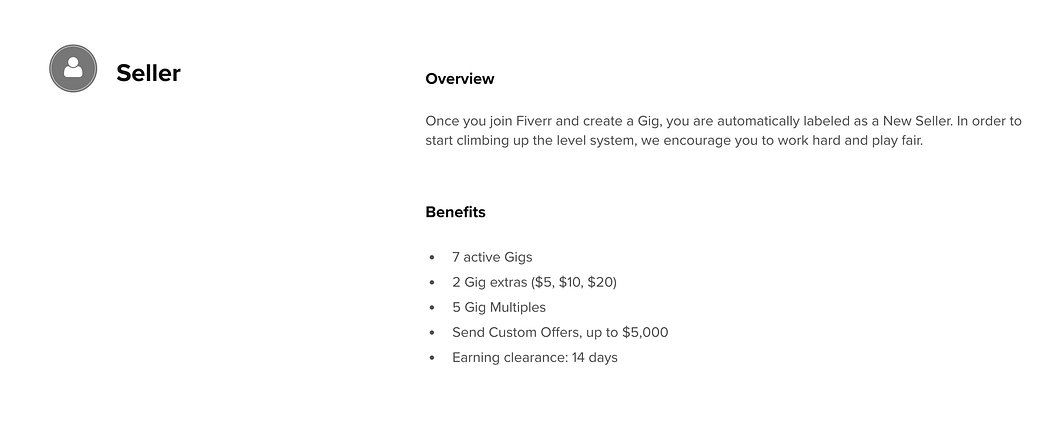
Fiverr Level One Seller
Moving up levels is beneficial because you’ll receive more visibility in search, plus eligibility to be featured in promotional listings — like what happened to me when Fiverr Pro launched.
Levelling up also unlocks additional customization options around your gigs.
At minimum, you won’t be eligible to become a Level One Seller until your Fiverr account has been active for at least 60 days. You must also complete at least 10 separate orders and earn a collective $400.
It’s at this point that various metrics start to become relevant: star ratings, response rate, order completion rate, and on-time delivery.
We’ll dig into what you need to understand about those metrics more after going through the rest of these levels.

Fiverr Level Two Seller
Aside from becoming a Top Rated Seller, Level Two Seller is the highest Fiverr level you can achieve on your own, automatically, by ticking the boxes associated with each requirement.
Notably, you’ll need to be active on Fiverr for 120 days, completely 50 orders, and earn at least $2,000 all-time.
One of the “benefits” of becoming a Level Two Seller is improved access to Fiverr Customer Support — though that’s not necessarily a relief. You’ll find out soon that Fiverr will usually side with a rogue buyer over an in-the-right seller in the majority of situations.
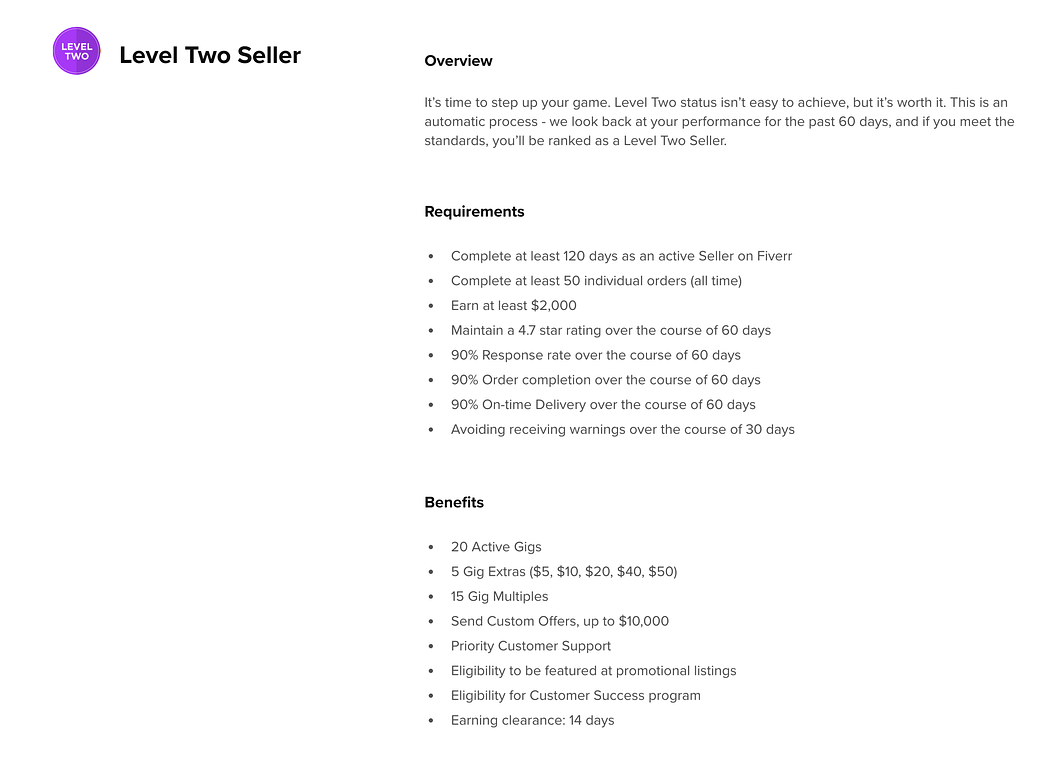
Fiverr Top Rated Seller
This is the highest Fiverr Seller level and I can assure you that it’s not easy to achieve.
Besides becoming a Fiverr Pro, the process to level up as a Top Rated Seller is not automatic. You will need to be manually approved and in addition to your current metrics, Fiverr will take past performance into consideration.
Notably, to qualify as a Top Rated Seller, you’ll need to be active on Fiverr for 180 days, complete 100 orders, and earn at least $20,000 (in addition to maintaining good metrics more generally).
To put this into perspective for someone just starting out, I don’t think I made $20,000 total on Fiverr until 2018, or 3+ years after initially signing up. That said, I never used Fiverr as my primary source for finding new business.
Here are my earnings from Fiverr as of 1/5/20, over four years after initially signing up for the platform:

Also notable — for all other levels, it takes 14 days for money earned from accepted deliveries to clear. As a Top Rated Seller, you need only wait 7 days after an order is completed.
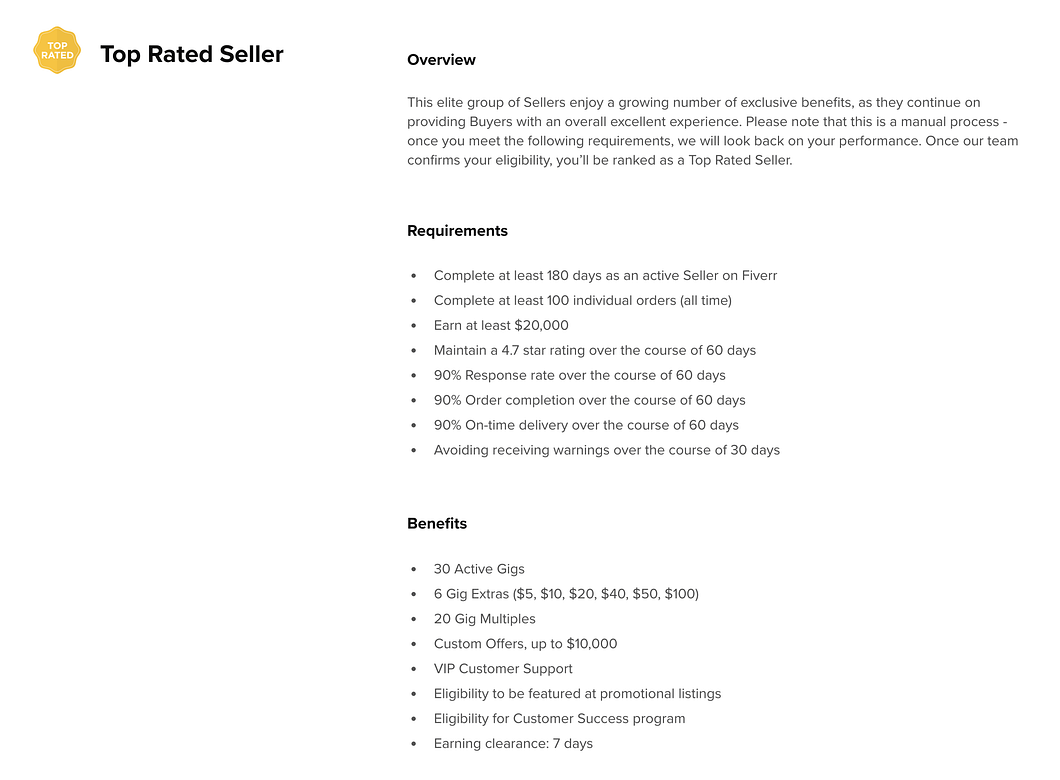
Fiverr Pro Seller
Strangely absent from Fiverr’s page detailing seller levels is a mention of Fiverr Pro, a niche marketplace of freelancers who’ve been personally vetted by Fiverr’s team.
In many ways, Fiverr Pro is a horizontal move from being a Top Rated Seller. Both distinctions help to justify higher pricing and will help direct a higher quantity of buyers towards your Gigs.
Fiverr Pros can charge premium prices because they guarantee a high level of quality with deliverables — which is harder to police on the wider Fiverr marketplace. Fiverr claims that only 1% of applicants make it through their vetting process.
Fiverr PR Manager Holly Steffy adds these additional details, “Pro sellers are hand-vetted based on their experience, not only on Fiverr but also offline and even on other platforms”.
Check out Fiverr Pro’s about page for more details regarding what sets Pro sellers apart.
When applying for Fiverr Pro, you’ll be asked to share social profiles, professional experience (including a portfolio if you have one), and educational experience. Make sure to detail major client wins, awards, and big names you’ve worked with to help Fiverr staff understand why you’re a cut above the rest and to push your application through.
If you want to be considered for Fiverr Pro, it’s important to realize that you’ll be approved for one narrow Gig category at a time.
For example, right now, I’m approved for Pro Gigs related to article writing and social media management. On the wider Fiverr marketplace, there are no restrictions regarding which Gigs you can offer across a variety of categories.
Besides the barrier created by skills tests, potentially.
On becoming a Pro seller, Fiverr PR Manager Holly Steffy adds,
“Skills tests are not a barrier to entry in order to create a Programming and Tech Gig on Fiverr. That said, in order to become a Pro seller, there are a variety of things one needs to share in order to be selected.
Internal Fiverr stakeholders look for a minimum of 3-5 samples of work.
For websites specifically, they want to see customization, mobile responsiveness, and integrations. In addition to checking out their portfolio of work, stakeholders are also looking at people’s resumes, LinkedIn profiles, personal sites, and more to verify the experience level”.
Fiverr Studios
Fiverr Studios allows you to work with other Fiverr sellers to deliver a project with multiple facets. For example, if you had a Fiverr Studios Gig for website design, you might have one seller who acts as the designer, another seller who does development work, as well as other sellers who help with copywriting and SEO.
This isn’t technically a Fiverr seller level but it is a distinction of sorts, with a set of rules that differs slightly from your average gig.

The person designated as “Studio Lead” acts as the project manager and single point of contact for the client:

I’ve got to say that Fiverr Studios intrigues me but I’d probably be uncomfortable risking my own metrics over someone else’s late delivery.
I asked Fiverr PR, “What are your tips for using Studios effectively? As a seller, I’d be worried that someone else would bring my metrics down”.
This was their response:
“Fiverr Studios is a great way for freelancers to collaborate and expand their skillset. It’s also an opportunity for them to expand their clientele by working on more complex projects.
Before a seller should determine if they would like to join a Studio, it’s important for them to take the time to vet other Studios members and make sure that everyone is aligned on the services being offered, expectations on timing for each part of the project, etc.
Many Fiverr Sellers already have existing relationships with other sellers from previous projects or referrals, which is a great place to start having those conversations”.
Unfortunately, this didn’t completely answer my question about how working with other sellers might impact your metrics.
But this Studios FAQ page does:

As does this:

As of right now, the feature is still currently in Beta and not available to all sellers.
So how do you apply? Right now it looks like Fiverr isn’t accepting applications but rather identifying and approaching sellers who they think would do well:

At any rate, improving and maintaining good metrics is an important aspect of growth on this marketplace.
Which brings me to my next point…
The importance of metrics for levelling up on Fiverr
Looking through the various requirements for moving up as a Fiverr seller provides some basic context for the level of service you’re expected to provide to customers on this platform.
Specifically, to maintain your level (without a downgrade) or move to the next, Fiverr expects you to maintain:
- A minimum average 4.7 star rating
- 90% response rate over 60 days
- 90% order completion rate over 60 days
- 90% on-time delivery over 60 days
- No warnings over 30 days
This is easier said than done. Especially because some aspects of these metrics are completely out of your control.
Let me give you an example:
The other day, someone bought one of my Gigs and immediately cancelled it. I’ve had no communications with this client prior to or after them placing this order.
I asked if my order completion rate would be affected and this is what Fiverr Support had to say:

Fun, right?
The fact that Fiverr can’t manually change aspects of the seller level algorithm in situations such as this is enough to make your blood boil.
But — all of this is to say that you can’t control everything, especially when you’re building your freelance business on rented land. So you’d better come to terms with that now if you don’t want Fiverr to drive you insane.
Here are a few tips for avoiding bad metrics in general:
- You automatically get a 1 star review if you’re late to deliver and someone cancels the order. So basically, avoid delivering late at all costs since this can also affect your on-time delivery metric. If necessary, you can opt to extend the order with approval from your buyer.
- Over delivering on expectations is a great way to guarantee 5 star reviews, which is an important metric for levelling up or maintaining a seller level. For my content writing Gig, this might mean going slightly over word count. For my UX audit Gig, this might mean filming a few extra minutes on a screen recording. And overdelivering doesn’t have to mean sacrificing profits — happy Fiverr customers are good tippers.
- Keep your response rate in the green by replying to all new messages within 24 hours. Even if you need time to think of a good response, respond ASAP to set expectations for when you’ll get back to someone. I’d recommend setting a calendar reminder to do this at the same time every day, so you don’t accidentally fall behind.
- Though response time isn’t a metric that affects your levels, it might be a factor when people are deliberating between working with you and another seller. It may also be a factor in Fiverr’s search algorithm for recommending Gigs to buyers. More speculation on Fiverr ranking factors can be found under the section of this article titled, “How does the Fiverr search algorithm work?”.
- Use Out of Office mode to pause new orders and even incoming messages if you need a break. If you’re serious about learning how to make money on Fiverr, you’ll realize that it’s better to lose out on orders than compromise your metrics if you’re otherwise too busy to keep up.
As to what the future of metrics might look like?
Says Fiverr PR Manager Holly Steffy, “Order completion, star ratings, and on-time delivery have always been among the top metrics”. She adds, “As the platform has grown, we are always looking out for what metrics are the most important for our buyer community and reflect that in how we measure a seller by their success”.
Which provides the perfect segue to the next section:
On Fiverr, the customer is always right
Now that you understand the differences between each Fiverr level and how to level up from one to another, it’s time to address a harsh truth that comes hand in hand with learning how to make money on Fiverr:
The customer is always right. Even when they’re completely wrong.
This is really my main gripe with Fiverr. By nature of completing so many orders and being on the platform for so many years, I was bound to deal with a few bad eggs, statistically speaking.
No matter the situation, in most cases, when a buyer decides that they don’t like your work, they will get a refund and it will come out of your earnings.
It doesn’t matter what “proof” you share with Customer Support — there have only been a handful of situations where I’ve come out on top with disputes involving buyers who’ve had a long history of abusing freelancers on Fiverr.
So I’m warning you now that if you invest your time in Fiverr, there will be some frustrating situations ahead of you. That said, these situations have become fewer and farther between now that I’m both a Pro and Top Rated Seller.
Here’s a good example of the frustrating divide between how Fiverr treats buyers compared to sellers:

In this situation, Fiverr chooses the buyer over the seller in two ways:
- Because buyers have an extended review period, orders completed on time will be paid out to the seller three to seven days later than expected if the seller decides to take this extra time (over a period of time typically associated with heavy spending).
- The seller is not given any additional business days to complete an order during the holidays, making it feel like their time is worth less than the buyer (we also appreciate having the time and space to enjoy the holidays with our friends and families).
In general, the cheaper your prices on Fiverr, the worse the class of buyers you’ll be dealing with. And this is just as true outside of Fiverr: the cheapest clients are usually those that expect the most from you while being the most difficult to work with.
It’s worth noting that if you start with cheap prices, it will be hard to later increase pricing with the clients you’ve already worked with. So ideally, start with sustainable pricing and adjust as necessary when you gain new experience and knowledge.
The real key to limiting awful client interactions on Fiverr is to be crystal clear about the nature of the deliverable you’re providing with each Gig package. You must also do your due diligence when collecting information from the client with the set of questions (known as Gig requirements) that trigger with each new order.
Finally, set a limit for revisions (even zero is fine), so that you and the client are on the same page about what’s included.
My standard offering for content writing services — including what I do outside of Fiverr — includes two revisions. This has helped me to get good reviews, earn great tips, and retain loyal customers.
But if you want to successfully learn how to make money on Fiverr, do whatever you can to give people what they want the first time, otherwise, revisions can take so much time that your Gigs are no longer profitable.
Selling yourself with your Fiverr profile
There are plenty of ways to communicate your expertise and experience on your Fiverr profile.
First off, Fiverr has a section where you can list “notable” clients. If you’ve worked with some big names, or cater to a specific industry and have a wide breadth of experience with others in the industry, make sure you’re using this section to showcase your expertise.
Fiverr also offers Skill Tests you can take to demonstrate basic proficiency across major service categories. I can tell you that I’ve never taken one and have still risen up the ranks, though this feature is new. I’m guessing that Skill Tests are probably most important for certain technical Gigs (or to demonstrate language proficiency).

Perhaps the weirdest sections you can fill out on your profile are “Professional Presence” and “Social Presence”.
Both invite you to share website and social media links but neither set of inputs become clickable in your profile, which makes me wonder why they’re there at all.

Fiverr PR Manager Holly Steffy helped clear things up, “Including social links in the seller’s profile is a great trust indicator to the buying community that they are an actual person behind their Fiverr account”.
Besides aiming to share complete details in sections about related skills, educational experience, and certifications, the best thing you can do is provide an elevator pitch of sorts in your profile description.
Make sure to answer these questions:
- What do you do?
- Who do you serve?
- What makes you different from your competition?
Get specific with regard to details. Share how long you’ve worked in your industry and what about it makes you excited to do your job. Feel free to share a bit of your personality too.
Put basically — give people something to talk about with you when they message you.
Holly Steffy also shared these additional tips:
“For a Fiverr Seller, their profile is how they present themselves to Fiverr’s global community. It’s an opportunity to introduce themselves, their background, talents, and experience to potential customers. The bio description should directly speak to who the seller is and their unique experience. Sellers should also take it upon themselves to fill in the available fields as much as possible.”
Since it’s easy to get stuck in your own head, I’d recommend asking someone (or a few people) to audit your Fiverr profile to see if you’ve missed anything important or if there any obvious questions you haven’t answered.
But in general, when it comes to learning how to make money on Fiverr, it’s better to just get started — even if your profile and Gigs aren’t 100% perfect. You can continue to optimize these assets over time.
Five star reviews can make or break your success on Fiverr
You’ll notice that to progress forward and maintain higher Seller levels, you have to maintain an average 4.7 star rating over 60 days.

This is easier said than done. Although most modern Fiverr customers aren’t cheap, they’re certainly critical.
Perhaps this is because Fiverr prompts buyers to share feedback with regards to the same metrics they measure in association with your account:

As a result, buyers will consider much more than just the final deliverable when leaving a star rating. They’ll take the whole order experience into consideration, so it’s in your best interest to over-communicate and over-deliver.
And over-delivering doesn’t have to mean doing extra work: it can mean delivering an order earlier than expected.
People have specifically brought this up in my reviews:

“On time” is another common phrase that comes up in association with my five star reviews:

…Which makes me think that there are plenty of Fiverr sellers that buyers work with who aren’t delivering on time.
And when I go above and beyond with a revision request, I usually get a great review (plus a tip):

When delivering an order, invite buyers to request changes or ask questions — not because you want extra work but because you don’t want to have to overcome the negative impacts of bad reviews.
At the end of the day, great reviews from clients who are really happy with you going the extra mile will win you the sale when buyers are comparing two similar sellers.
I asked Fiverr PR Manager Holly Steffy if there was any reason to feel compelled to reply to a seller’s review and she said:
“This shows appreciation to the buyer but it also shows potential buyers that the seller is engaged with their customers. If a seller receives a review that isn’t favorable, it also allows them the opportunity to respond with their side of the story in a respectful manner”.
Which totally makes sense — both for good and bad situations.
I was curious to learn more about the words that come up most commonly in association with my own reviews (including the buyers most likely to leave them).
Here’s a word cloud based on my last 12 months of Fiverr reviews:

I’m sure you’re wondering — what happens if you want to move client relationships off Fiverr?
Answering this question requires first taking a step back. Specifically, because Fiverr makes a cut of every sale, they have a vested interest in keeping your client relationships on their platform.
In fact, they’re so interested in training you to be loyal that they offer commission-free transactions for any of your own clients that you bring over to their platform.
Because Fiverr wants to own these client relationships, you’ll get a warning — up to account suspension — if you attempt to move communications that started on Fiverr off the Fiverr platform.
Sure, there are some exceptions. For example, when clients get in touch asking for portfolio samples, Fiverr won’t punish me if I send links to my portfolio website (though I can’t share clickable links to my own properties on any public-facing aspects of my Fiverr profile).
👉 By the way, if you don’t have a portfolio website yet, consider building one yourself using one of these platforms.
Sometimes, clients ask if we can hop on a phone call before placing an order and I have to say no. Technically, Fiverr offers some video call functionality but I’m not really interested in using it. If I have to spend a lot of time on the relationship before an order, it kind of defeats the purpose of Fiverr for me (and stops justifying their 20% cut).
👉 Also read: best appointment scheduling software for your business compared
All of this is to basically say that you shouldn’t make any obvious attempts to move a client relationship off Fiverr, because it will likely get your account banned.
How to keep Fiverr clients happy: tips for working with Fiverr customers
Even if you don’t want to work with a particular client on another order, you’ll want to follow some best practices to maintain (or improve upon) your current Fiverr Seller level.
This might start with a mindset shift.
If you really want to figure out how to make money on Fiverr, you need to get over the thought process that it’s a place for cheap customers. Not everyone, not even most users that I work with, are cheap customers — especially those that purchase Pro orders.
On average, I get tipped on orders at least once a week, up to $40 on top of the amount already paid.
It’s worth noting that even though PayPal offers a tipping feature, I would never add a tip option to my regular invoices outside of Fiverr. It’s just not appropriate. But it’s nice to know that it’s an option on this platform that people can use if they want but shouldn’t feel pressured to.
Really, tips are a reward for going above and beyond.
Are you starting to notice my “underpromise and overdeliver” theme?
All that said, some people will try to get you to do work before an order. Ideally, you have some sort of basic Gig package that you can suggest for them they buy, even if it’s not an exact match for the help someone wants.
If they’re pushing for an answer to a complicated question, you can direct them there and say you’re happy to spend your time answering their questions if they want to buy that Gig.
My SEO Gig, specifically the Basic package, is a good example of what I recommend to clients who are asking me to investigate SEO questions they have.
Another way to limit the time you spend with a prospect before they become a client is to use quick response templates.

A few of my follow up templates include:
- A general invitation to ask questions
- Language for communicating specifics around certain Gigs
- Shortlinks to samples of finished work on Google Drive
On a related note, know your pricing specifics off the top of your head (or with an easily referenceable document) because people, inevitably, will ignore what it says on your Gig and ask you for details via direct message.
Since your response rate is an important metric, you’ll want to know your pricing well enough to quote orders even when you’re not at your computer and are responding on your phone.
Knowing your pricing is also important because people will ask for custom scenarios and you want to be able to accommodate them — especially because custom packages usually mean higher price points.
That said, if someone is requesting a custom order that more or less fits the scope of one of your existing packages, don’t hesitate to direct them to order that way.
Here’s another important housekeeping tip:
Use vacation mode whenever you have reason to believe you won’t be able to take on new orders, especially if you have Gigs with one-day turnaround options.
You don’t want to be put in a situation where you disappoint someone who needs something tomorrow, then have your metrics suffer as a result of not being able to accommodate the order.
For more insights regarding the importance of user metrics and how to keep them high, jump to the section of this article titled “The importance of metrics for levelling up on Fiverr“.
I asked PR Manager Holly Steffy for Fiverr’s tips for client communication best practices and here’s what she said:
- It’s crucial for Fiverr freelancers to practice transparency and provide as much information as possible to the buyer on what they can deliver, the expected timeline, and provide which dates on when they will be reaching out to the customer, and breakdown of the overall price.
- Regular communication between the seller and buyer throughout the entire process is key. Sellers should provide regular updates on the status of the project.
- Buyers aren’t the experts on the subject matter, sellers are! So sellers should make sure they are breaking down the language into layman’s terms so it’s easy for the buyer to understand.
- Sellers should always be proactive and should never leave a client wondering where they stand with their order. Every message should be a call to action. “Shall I send you a custom offer? How does that sound? What do you think about XYZ?”
These are all solid tips in my experience. Especially that last one — it’ll be hard to convert the people who message you into buyers without a specific plan of action.
One last tip for dealing with customers:
Some buyers are jerks and will keep requesting modifications after you deliver an order, claiming that it’s not what they want, until you give in and let them cancel it — refunding their money from your account.
I’m sorry to be the one to break it to you but in most cases, you’ll save a lot of time by just giving in. Even if you fully stand by the work you created.
Trust me when I say that it’s just not worth the fight, especially over a small order value. At this point in time, Fiverr cares more about the customer than they care about you — and they probably always will.
How Fiverr can create a better seller experience
If you’ve made it this far, you know that overall, I’m very happy with my experience as a seller on Fiverr. But you also know that I have a few bones to pick.
Although Fiverr has made many improvements since their early days of Gigs that had to start at $5, they still have some work to do to create an ideal seller experience.
Here are my suggestions:
- Don’t take a percentage of tips. If I’m overdelivering for a client, I should keep the extra money I make. This overdelivering also helps to create a loyal Fiverr customer who buys more Gigs from other sellers — that’s enough of a benefit to Fiverr on top of the service fees they’ve already collected from me and the client.
- Measure delivery time in business days. I often get orders with a due date on weekends or holidays. There are no safeguards from this besides setting reminders, then manually setting your Out of Office during these timeframes (orders could still come through for those due dates before setting your Out of Office, though). I don’t think I’m alone in wanting to maintain a decent work/life balance — not arbitrarily being forced to work on weekends or holidays.
- Take the buyer’s side publicly but compensate the seller if they’re technically in the right. Look, I don’t care what you have to tell a buyer who reaches out to Customer Support to get them to stop complaining. But don’t screw me over to make someone happy who’s technically in the wrong about their complaint. If you take 20% of each order I sell, there must be enough of a buffer to account for the occasional bad client scenario — especially for sellers who’ve paid their dues and have seniority on the platform.
- Manually review for every seller level. I’ve pointed out some issues with Fiverr’s seller levels algorithm in this article that an automated process can’t always account for. I think that sellers should at least have the option to request a manual review when applicable, offering their own evidence for why their level shouldn’t be downgraded.
- Don’t automatically create one star reviews for late orders that get cancelled. By all means, give the buyer the option to do so (up to suggesting a one star review for having to deal with the bad experience) but it seems unfair to deploy this rating automatically, based on its impact on your level maintenance.
- Fix mobile application issues. My inbox messages and notifications don’t completely match what I see on the desktop website, which means I sometimes miss important communications if I’m working out of pocket that day. As a result, metrics are negatively impacted for no reason other than technology problems.
Using Fiverr as a buyer to outsource business tasks
Besides using Fiverr as a seller, I highly recommend trying it out as a buyer.
Doing this will help to inform the experience you’re providing to your own customers. It might even be a good idea to buy Gigs that are similar to the ones you offer, to get a better understanding for the competition in terms of how they merchandise their Gig, what their deliverables look like, and how they communicate throughout the process.
But you should also consider using Fiverr to outsource business tasks that you neither want to deal with nor have the experience to execute well.
Personally, I’ve used Fiverr for basic graphic design needs, help with specific WordPress fixes I don’t want to deal with, and help setting up Mailchimp.
It’s worth noting that you can use the balance you’ve accrued from completing Gigs to pay for other Gigs without a service fee.
Final thoughts on how to make $2-3k every month with a Fiverr side hustle
If you’re serious about learning how to make money on Fiverr, this checklist, mirroring my own approach, will help you cover your bases and set you up for success:
- Sign up as a Fiverr Seller
- Brainstorm the Gigs you want to set up
- Create a compelling Fiverr profile
- Research how the competition is setting up their Gigs
- Take a first attempt at setting up a Gig, then ask someone in your industry to review it and point out anything that isn’t clear or compelling
- Refine your initial attempt at setting up a Gig with representative imagery, a clear title, a keyword-rich description, relevant search tags, and a helpful FAQ
- Set Gig requirements that aim to get all relevant information from the buyer to limit the need for revisions
- Acknowledge every incoming order, if only to keep your metrics high
- Set aside a specific time each day to address client communications and to work on Fiverr orders
- Use client feedback to refine Gig messaging (including FAQs), Gig extras, and to launch new Gigs
- Underpromise and overdeliver whenever possible
Regardless of how you find clients, making enough money for your freelance business to thrive doesn’t happen overnight. It probably won’t happen in a year, either. It’s a long game and the only way to find success is to be consistent.
It also doesn’t hurt if you’re constantly exceeding clients’ expectations for you.
Fiverr isn’t so different from other freelance platforms in terms of how you need to represent your skills to get clients. The metrics that determine your seller level provide useful guidance around how to be a good communicator with clients — even outside of the platform. Keeping any client happy means responding in a timely manner, completing all the orders you take on, and delivering on time.
Fiverr isn’t perfect — it’s still finding itself and determining the type of company it wants to be. But I think that Fiverr has made massive strides forward from their initial days as the platform deplored for its insistence on Gigs starting at $5.
Today, I feel like they’re team partners with me to both of our mutual success.
Fiverr employees, including those who work for Fiverr’s sister brands (And.co and Veed.me), regularly purchase my full price Gigs (often my $400 blog writing package) and are a dream to work with. When the Fiverr team needs help with a project, they start with their own marketplace and reward sellers who demonstrate professionalism and produce high-quality deliverables.
The longer you stay consistent on Fiverr, the more opportunities that will open up for you. Once you understand the system, it will be easier to navigate and you’ll have a better understanding of how to make money on Fiverr.
But I’m not the only one who’s created a successful side gig with this freelance marketplace. Tell me: how have you made good money on Fiverr? Or if you’re just getting started, what other questions do you have about navigating this platform?
Sound off in the comments!


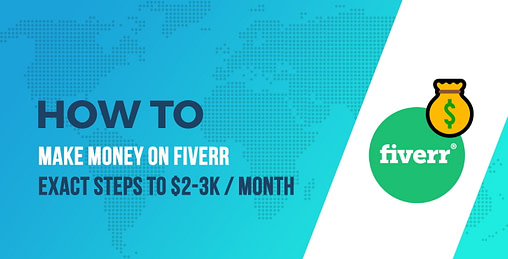


No comments:
Post a Comment